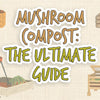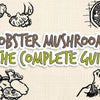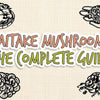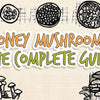Oyster Mushrooms: The Definitive Guide
Below a complete and comprehensive guide to oyster mushrooms. Featuring everything from nutritional information, foraging, growing, processing, preserving and eating!
The oyster mushroom is probably the most cultivated mushrooms on Earth, often going by the name abalone or tree mushroom.
With a mild flavour it can be eaten raw or cooked, accompanying meat dishes or as a substitute. This is a versatile mushroom.
Not Much Time? Skip To What You'd Like To Learn...
-
History
-
Common Variations
-
5 Health Benefits Of Eating
-
Foraging
-
How To Grow At Home
-
Cleaning And Preparation
-
Methods To Preserve
-
Dehydrating
-
Freezing
-
Pickling
-
Recipes
History
Otherwise known as pleurotus ostreatus, can be found all over the world. First grown commercially in Germany, this fungi played an important role in World War 1. Since then it has been widely cultivated all over the world.
This specie is easy to grow - possible in most environments. Making them popular for growing kits, mass cultivation and farming.
The “Oyster Mushroom” got its names from the shape of the tip. All Oyster mushrooms or pleurotus comes from the genus gilled mushrooms. In this article we will refer to their common names. Also we will explore some of the most popular variations.
Common Variations

Oyster Mushroom or Pleurotus Ostreatus
Shaped like an oyster and some even say it has a slightly oyster taste. No wonder this is commonly known as the oyster mushroom.
Pink Oyster Mushroom or Pleurotus Djamor
The appearance gives it the name. A mushroom with a firm texture and juicy taste this mushroom is perfect as a meat substitute or saute´ and eat as an accompanying dish. It can be found naturally in tropical hardwood environments.
Golden Oyster Mushroom or Pleurotus Citrinopileatus
Large golden caps identify this mushroom. Naturally found in north-subtropical asia, growing specifically on hardwood trees in Northern China and Southern Russia. Easy to grow at home these have become popular in home grow kits and DIY growing videos. Often touted for their specific health benefits and used in eastern traditional medicine.
King Oyster Mushroom or Pleurotus Eryngii
The largest species giving them their name. Often eaten in soups, stir-fried or sautéed these are versatile. Also unlike most other oyster mushrooms the stems can be eaten. You’re likely to see these in your local Asian supermarket or even at your local Mediterranean restaurant.
Blue Oyster Mushroom
With light blue caps these mushrooms can be spotted throughout North American woodland. Due to the easy to grow nature of them they can also be found in all-in-one growing kits. Very similar in taste, this variety is commonly found on restaurant menus.
5 Health Benefits
Due to only being commercially cultivated for just over 100 years, they have never been used in traditional eastern medicine. Unlike reishi fungi for example which have been used for hundreds of years. Therefore the scientific studies haven’t yet had the chance to delve as deeply into the benefits of consuming them.
Anti-inflammatory: in reaction to an infection or injury the body acts to protect itself, causing inflammation. However chronic inflammation is thought to cause diseases including cancer (link). Studies show that they may reduce inflammation thus potentially reducing the risk of cancer (link).
Antioxidants - Preventing Cell Damage: They have been shown to have large amounts of antioxidants in them (link). Antioxidants stop free radicals and in turn protected our cells. Healthy cells are central to a healthy body.
Lower Blood Sugar & Cholesterol Levels: in a study conducted on patients with diabetes, they were shown to have a significant positive result in reducing blood sugar and cholesterol levels (study).
Boost Your Immune System: studies show that oyster mushrooms do enhance and boost your immune system. The immune system is responsible for helping us fight infections and diseases. Once disease they may fight is cancer. (study)
Antibacterial Effects: As show in a study published in the Journal of Agricultural and Food Chemistry to have large antibacterial effects. It’s believed to be the same mechanism which allows mushrooms to digest food and fight infections in the human body.
Foraging

When foraging we would always recommend using mushroom knife for ease of use, and a clean cut. Interested in learning more about mushroom knives? Click Here For The Complete Guide To Mushroom Knives
Where To Find? They are one of the easiest fungi to grow, you can find them in North America, Europe and Asia too. They grow on dead hardwood and softwood trees. Optimal conditions provided, you could find many pounds all growing together.
When To Find Them? Every Season! If the conditions are right this type of mushroom can grow all year round.
When To Pick? They grow quickly and only the young ones taste good. The older they get the worse they taste. Be sure to only pick the ones.
How To Pick? It’s still necessary to use a knife and we would recommend only picking the young ones. The old ones should be left to help more mushrooms spore in the future. (link to our selection of mushroom knives)
How To Identify?
WARNING: never pick or eat mushrooms unless under the strict guidance of an expert. Below is a brief overview for those interested in certain characteristics and not to be take as a guide. In the US there are the western jack o lantern mushroom and many others which are poisonous look a-likes.
Appearance
-
Gills running from bottom to top
-
Oyster or clam like shape
-
Grey, White, Pink, Tan
-
Little or maybe no stem
-
White flesh
Size
-
5-25 cm
Habitat
-
Found in large clumps together
-
Found in or on dead trees (most often hardwood trees)
-
Growing in the shade
How To Grow At Home
Want to know our Top 10 Mushrooms Growing Kits? We have a full and comprehensive guide to the best growing kits and considerations before buying one too! Check out our Top 10 Mushroom Growing Kits Here.
Oyster mushrooms are one of the easiest types of mushroom to grow. It’s possible to grow them indoors and all year round with very little work required. Multiple vessels can be used to grow too. Popular indoor vessels include sawdust, straw and coffee grounds. It is necessary to pasteurised straw before using otherwise the microorganisms in the straw will compete with the mycelium for nutrients and growth.
Equipment And Materials Required For Growth:
-
Oyster Mushroom Spawn
-
Growing Material (fresh coffee grounds, pasteurised straw or sawdust)
-
Growing Bag
-
Spraying Bottle
-
Non-Chlorinated Water
1. Inoculation: The process of mixing the mycelium with the growing material.
Once you have selected the growing vessel mix the mycelium with it at the desired ratio is 1:5. E.G 1Kg of oyster mushroom spawn with 5kg of growing material (sawdust, straw etc). Ensure you have fully mixed these two materials together for best results.
2. Incubation: Over the next 10-21 days the spawns start to grow turning your whole bag a
white color.
For this process to happen we recommend that you store in an airing cupboard.
Optimal Environment:
-
Temperature: 18-24°C or 64-75°F
-
Light: Shaded or Dark environment (no direct sunlight)
3. Fruiting: When fully incubated (the whole mixture looks white) move the bag to an environment that is shady but gets fresh air - a kitchen may be ideal. Make a square opening in the side or top.
4. Caring: It may take up to 2 weeks for your mushrooms to fully grow. During this period you should mist with water twice per day. It is recommend that you use fresh unchlorinated water as the chlorine may kill your mushrooms.
5. Harvesting: Once the mushrooms are ready to eat simply slice the stems with a knife and then get ready to eat!
6. Multiple Flushes: It should be possible to get multiple flushes of mushrooms from this bag. Keep misting twice per day and within a few weeks more mushrooms should appear. Once the mycelium no longer produces break up and put on your compost.
Cleaning And Preparation
Whether you grow, foraged or brought your mushrooms before cooking you will need to clean and prepare them. Oyster mushrooms grow in bunches all with one stem in the middle.
Also if you're looking for fridge storage you can check our guide our here.
1. Cut the central stem with a sharp knife. The individual stems should all come apart now. The stem isn’t tasty to eat, so normally get thrown away - however can be used later on for stock.
2. Cleaning oyster mushrooms is very straightforward just rinse under a tap and make sure any dirt is washed off, leaving the mushroom clean.
3. Eat! Now your mushrooms are ready to be cooked.
Preservation Methods
Due to the easy nature of growing and the frequency of flushes, you’re likely to have more than you can eat!
Dehydrating
Commonly found in asian supermarkets are dehydrated mushrooms. A simple yet effective method for preservation.
1. Clean your mushrooms by rinsing them under the tap. Ensure that there is no dirt left on them.
2. Once clean prepare by slicing into strips. Remember the thicker that the strips are the longer that it will take to dehydrate. Also consider what you would like to do with them after cooking, would you like them thick and meaty for a soup or thin to stir-fry?
3. Place on your dehydrator tray. Space them evenly out with no overlap. This is necessary to dehydrate them evenly. It’s likely to take between 3-8 hours depending on your dehydrator and the thickness of the mushrooms.
4. Once dehydrated they can be stored in a jar or air tight bag. A cupboard at an ambient temperature will be the ideal place for storage. Remember: always write the date and type on mushroom on your bag or jar.
5. Rehydrating is simple. Just place them in a heat resistant bowl and cover them in boiling water for roughly 30 minutes. Once fully rehydrated you can then use them like normal fresh mushrooms
Freezing
Before freezing your mushrooms be sure to cook them. Uncooked fungi when thawed will be all soggy and mushy - not ideal! Blanching or steaming before they will be best suited to stews or soups. If you saute prior to freezing remember that the taste of what oil or fat they have been cooked in will remain.
For a full comprehensive freezing guide you can check it out here.
Frozen mushrooms should be edible for up to 1 year. Ensure that you label the date, type of mushroom and cooking method on any frozen packet.
Blanching Method
What You’ll Need:
-
Large boiling pot
-
Colander or sieve
-
Cold Water Bowl
-
Bowl for drainage
-
Storage container, either suitable freeze bag or box
1. Clean you mushrooms thoroughly before starting.
2. Decide what size you want your mushrooms, think about what you will do with them after you defrost them
3. Bring a large pan to a boil
4. Put your mushrooms in and let them boil for 3 minutes
5. Plunge immediately into cold water to halt the cooking process
6. Drain your mushrooms by letting them rest in the colander over a bowl. It’s essential that you properly drain your mushrooms and no excess water is in the freezing bad - this will cause your mushrooms to be excessively soggy
7. Place in your freezer container or suitable zip lock bag then add to your freezer
Saute Method
What You’ll Need:
Saucepan
-
Fat or oil to cook in
-
Storage container, either suitable freezer bag or box
-
Pinches of salt and pepper
-
Garlic to taste
1. Clean your mushrooms thoroughly and ensure all dirt is removed prior to cooking
2. Cut your mushrooms to the desired size - think ahead to what you would like to do with your mushrooms after defrosting
3. Add your desired fat in the pan and heat up over a medium heat
4. Add your garlic and mushrooms, cook until a golden brown
5. Season and turn your heat down for another 5 minutes
6. When ready remove them from the heat and let them simmer until tender
7. Let your mushrooms cool down
8. When cool put them in your container and into the freezer
Pickling
Warning: when using mason jars make sure that it can withstand fast temperature changes. When adding hot or boiling water to a jar low quality jar they may break and smash. Check with the manufacturer's specification to ensure they can withstand the fast temperature changes.
Pickling is a preserving technique that has been used for thousands of years. It involves submerging your chosen food into vinegar or brine. As the PH is below 4.5 it kills harmful bacteria allowing your pickled food to be edible for months or even years to come.
Ingredients Required
-
2 lbs Of Oyster Mushrooms
-
2 Cups Of White Wine Vinegar
-
2-4 Cloves Of Garlic
-
2-4 Dried Chillies
-
4 Sprigs Of Thyme
-
1 tbsp Of Sea Salt
Pickling Recipe
1. Clean your mushrooms thoroughly
2. Add your mushrooms, vinegar, garlic, thyme, chillies, salt and water into a pot
3. Bring your pot to the boil and then let it simmer
4. Cook for roughly 10 minutes, it will be ready when your mushrooms have shrunk and shiny to look at
5. When finished spoon your cooked mushrooms, vinegar, garlic, chilli (leave thyme) into your jar
6. Pour your brine into the jar covering the ingredients - be sure to leave roughly 1” of room in the top of the jar
7. Leave in a cool environment to let cool down, leave for at least 10 days before eating
8. Be sure to add a label with whats inside and the date pickled
9. Once opened leave in the fridge
For longer term storage it is necessary to use a specific canning jar, as well as boiling that jar in water once sealed. The above method should keep your pickled mushrooms good for 6 months when in the fridge.

With a delicious and meaty taste these mushrooms can be enjoyed to eat on their own by simply sautéing or accompanying a variety of dishes.
Sautéed Oyster Mushrooms
Ingredients
-
10 oz Of Oyster Mushrooms
-
4 Spring Onions
-
2 Cloves Of Garlic
-
2 Tbsp Of Salted Butter
-
Pinch of Salt and Pepper
1. Thoroughly wash your fungi and slice into pieces
2. Chop your spring onions into chunks
3. Warm your pan over a medium heat and add 2 tbsp of unsalted butter, and garlic
4. Mix together and ensure all ingredients are coated in butter
5. Add your Oyster Mushrooms and spring onions
6. Stir together until your mushrooms are a golden brown
7. Serve on a plate with your salt and pepper
Oyster Mushroom Risotto
Ingredients
-
1 tbsp of butter
-
1 Brown Onion, chopped finely
-
2 Cloves of garlic, diced
-
1 lb (500g) of oyster mushrooms
-
11 Oz (300g) risotto rice
1 cup (250ml) of white wine -
1 ½ cups (1.5 litres) of chicken stock
-
½ a bunch of parsley
-
Parmesan to taste
1. Place you pan over a medium heat and melt your butter
2. Fry your onions and garlic together until brown
3. Add your 'shrooms to the pan
4. Once your mushrooms are cooked at the risotto rice
5. Add your chicken stock
6. Let simmer for 20 minutes or until cooked through
7. When ready serve with parmesan and parsley to taste










I would have liked another canning recipe instead of just a pickling one.